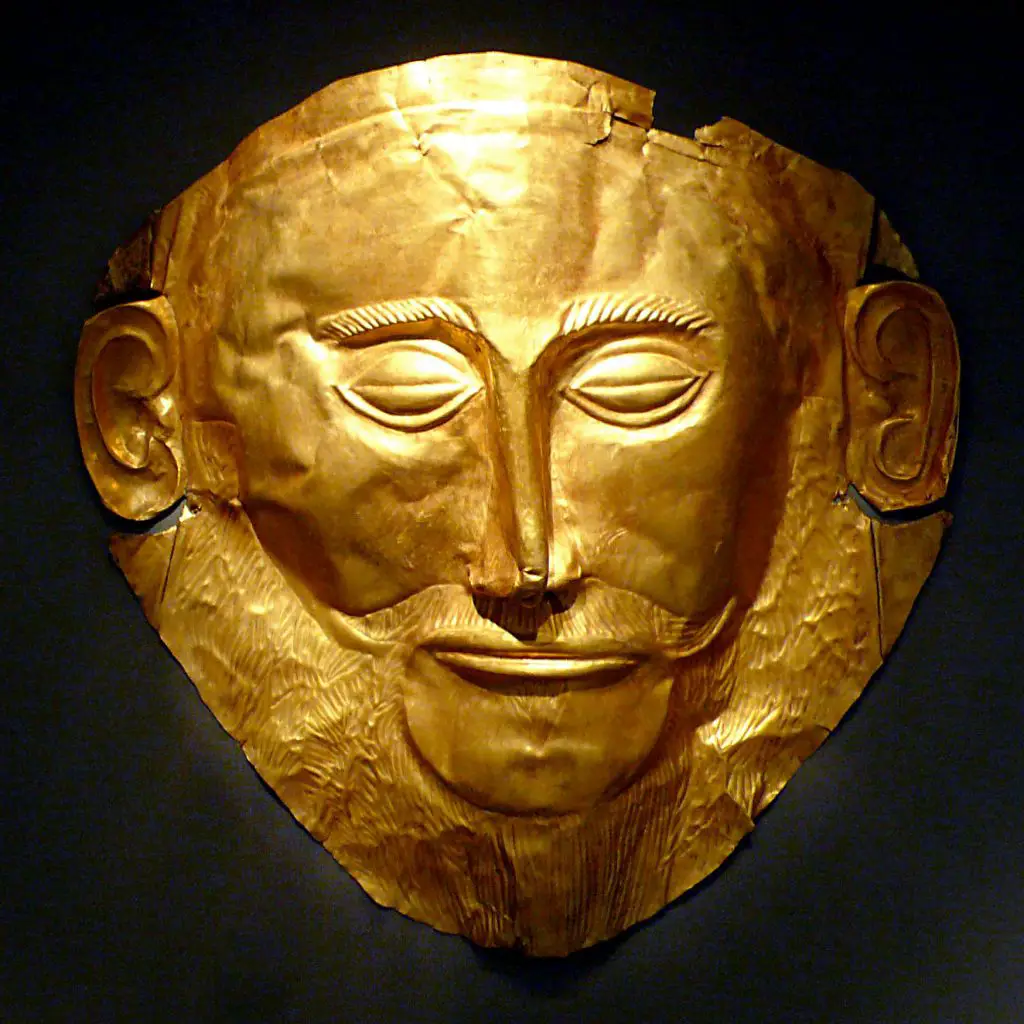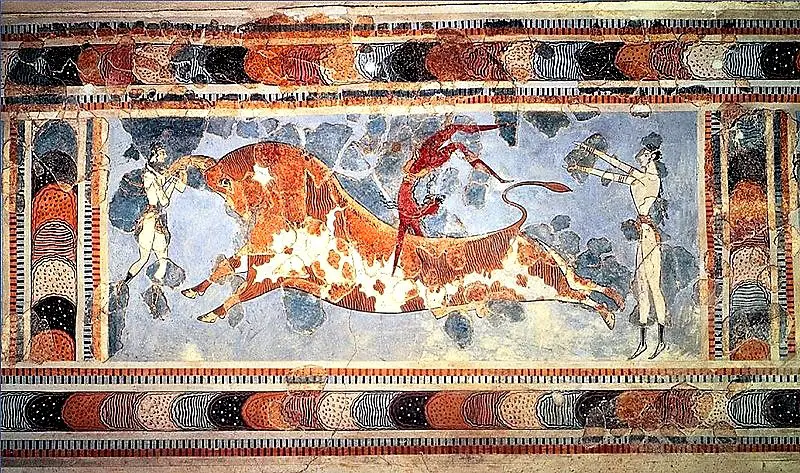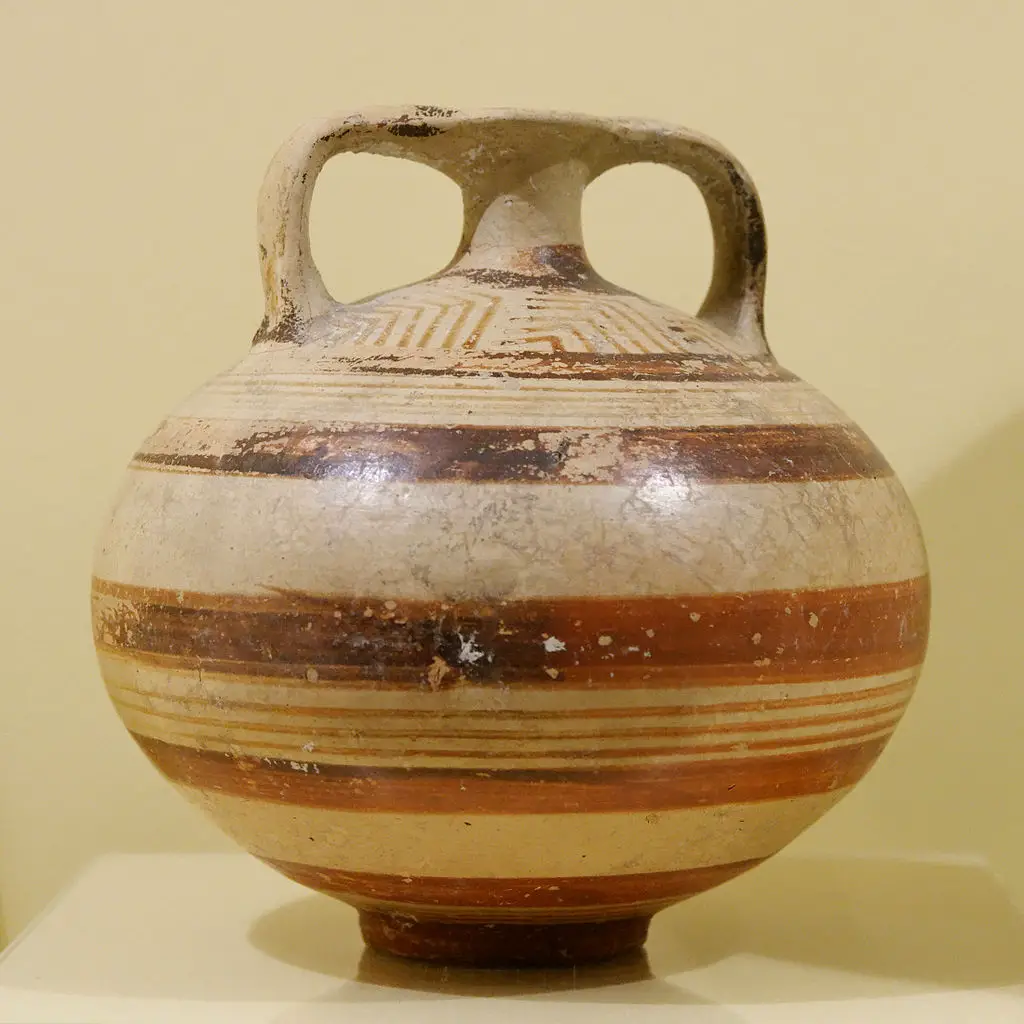The Minoans and Myceneans were Ancient Greek civilizations during Ancient Greece’s Bronze Age. As two of the earliest Ancient Greek civilizations, the Minoans and Myceneans had a major influence on Greek culture and history.
The Minoans
The Minoans lived on the Greek island of Crete from around 2000 to 1400 BC. Their civilization was named after King Minos.
They spoke an unknown ancient language. Archeologists have found tablets with Minoan symbols and scripts similar to hieroglyphics. They call the Minoan language Linear A.
The Minoans were known for their architecture and art, especially pottery and sculpture. They built an empire based on trade.

Architecture
The Minoans built large, complex palace structures. The most well-known is Knossos, which covered about 15,000 square feet. That’s the size of more than two football fields!
According to Greek mythology, King Minos built a labyrinth (a complicated maze) under the palace where a monster called the Minotaur lived.
Other major Minoan palaces include Phaistos, Malia, and Zakros. The Minoans had several main cities built around these palace complexes. Taxes were collected and stored at the palaces, then redistributed to support trade, the arts, and government.
Additional Minoan settlements, tombs, and cemeteries have been discovered all over Crete.
Art
The art created by the Minoans was very advanced for its time. They made a wide variety of pottery and ceramics. These items were decorated with images of flowers, plants, and sea life.
Many Minoan bronze figurines of men, women, and animals have also been found, often in active poses.
Minoan palaces were decorated with frescoes of all sizes. They often painted the sea and other elements of nature. They were one of the first cultures to paint natural landscapes with no humans in the scene.
Trade
With their location in the Mediterranean, the Minoans depended on their navy and trade for wealth and power.
They were travel experts who made connections with many neighboring civilizations. The Minoans traded and sold wood and timber, ceramics, gold and silver, and spices like saffron.
A Peaceful Civilization
Partly because they were isolated from most other civilizations, the Minoans were a peaceful civilization.
They did not build fortifications (walls built for defense and protection against invaders). While the art of most ancient civilizations shows scenes of war, Minoan artwork shows flowers, dolphins, and other elements of nature.
The Fall of the Minoans
After a huge volcanic eruption on a nearby islands, the Minoans were weakened. Shock waves from the volcano destroyed Crete’s cities. The volcano also caused a tidal wave that wiped out the Minoan navy.
Volcanic ash poisoned the Minoan’s crops. After this, the civilization was eventually taken over by the Myceneans.
Other Interesting Facts About the Minoans
- The Minoans worshipped mostly female deities. They worshipped a mother goddess associated with fertility (having children) and other goddesses who had jobs like protecting animals, the harvest, and households.
- Minoan women seem to have had more power and freedom than most other women of the time period. In Minoan art, they can be seen participating in many activities with men, including jumping over charging bulls.
- Minoan culture was heavily influenced by Egypt and Mesopotamia.
- The Minoans were so advanced that they even had water pipes, sewers, and toilets with pipes leading to outside drains.

The Myceneans
The Myceneans lived on the Greek mainland. They were the first to speak the Greek language and are sometimes called “the first Greeks.”
They got their name from their largest city, Mycenae, which had a population of 30,000 people. Other Mycenean cities like Thebes and Athens eventually grew into major city-states during the height of Ancient Greece.
Eventually, the Myceneans conquered the Minoans and took over the island of Crete. They adopted much of the Minoan culture.
The Myceneans formed their own written language based on the Minoan written language (Linear A). This new written language, Linear B, was used to record Mycenean Greek. Unlike Linear A, Linear B has been successfully translated.
Architecture
Most Mycenean centers or major cities had large palace complexes. They were built around a large central hall called a Megaron. The Megaron was also the throne room.
Palace complexes were surrounded by fortification walls built of large blocks. Later Greeks, who did not know about the Myceneans, believed these walls were built by giants called Cyclops. They thought only giants could have moved such massive stones
Other Mycenean architectural structures included dams to manage flooding and bridges built from stone blocks.
Art
In many ways, Mycenean artwork was similar to Minoan artwork. The most popular forms of Mycenean art were pottery, jewelry, and fresco. Geometric designs were popular too.
Rooms in Mycenean palaces were decorated with fresco paintings. These paintings were usually of plants, lions, griffins, battle scenes, warriors, chariots, and popular activities like bull-leaping and boar hunts.

Trade and War
The Myceneans were extremely wealthy. Like the Minoans, they built ships and traded and sold goods like spices, honey, wine, and olive oil. But they also built their fortune on war, conquest, and piracy.
The perfume and metal industries were important too, and the Myceneans started the Greek textile industry.
The Fall of the Myceneans
The fall of the Myceneans is mysterious. Historians aren’t sure exactly what happened. The Myceneans may have been invaded and conquered by outsiders or weakened by civil wars between the rich and the poor.
Another theory is that a natural disaster, like an earthquake, destroyed the Myceneans. Either way, the period after Mycenean rule was known as the Dark Ages.
This was a period of decline and famine. It took many years for Ancient Greece to rise again. Eventually, Greek city-states began to form, gain power, and develop Greek culture, philosophy, education, and government.
Other Interesting Facts About the Myceneans
- There were many wars during the Mycenean period, and resources became scarce throughout Greece, which caused even more fighting. This contributed to the fall of the Myceneans and the beginning of the Dark Ages.
- Mycenean warriors wore helmets made of boar tusks.
- Historians don’t know much about Mycenean religion. They do know that animal sacrifices were important to the Myceneans.
- The Minoans and Myceneans were laid the foundation for the classical Ancient Greek culture that is known today.
More on Ancient Greece.